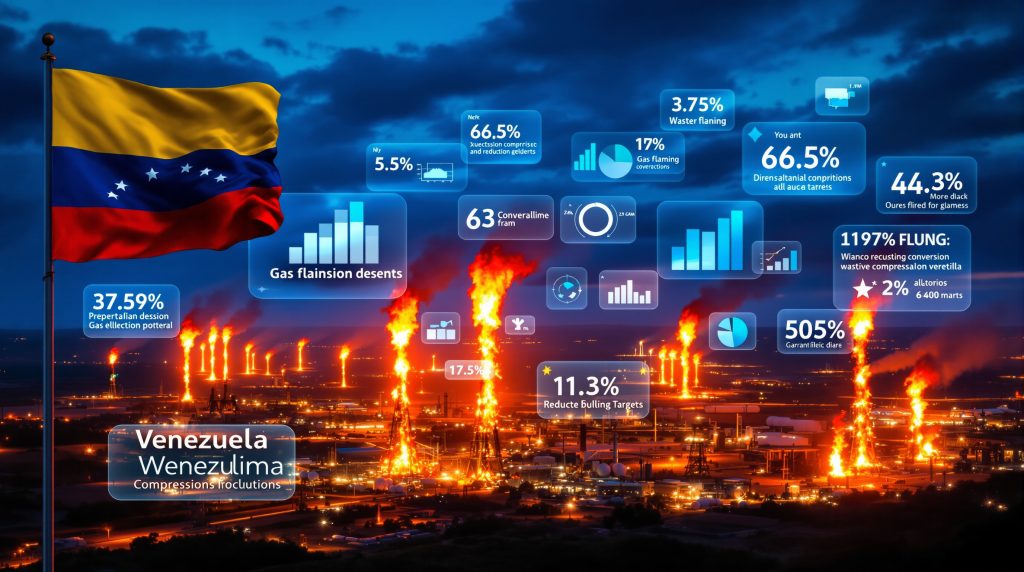Understanding Venezuela's Environmental Challenge: The Scale of Gas Flaring
Venezuela faces one of the world's most critical gas flaring challenges, with infrastructure decay and economic constraints forcing the country to waste approximately half of its total gas production. According to industry data from October 2025, Venezuela produces roughly 4 billion cubic feet per day (Bcf/d) of natural gas, yet flares approximately 2 Bcf/d due to insufficient processing capacity and deteriorated infrastructure systems.
The scale of this environmental crisis becomes particularly striking when considering that about 90% of Venezuela's gas production consists of associated gas, meaning it cannot be curtailed independently from oil extraction operations. This fundamental constraint means that as long as oil production continues, gas will be produced regardless of whether adequate infrastructure exists to capture and utilise it effectively.
Geographic Distribution of Venezuela Gas Flaring Reduction Impact
The government's venezuela gas flaring reduction strategy focuses primarily on the country's two largest gas-producing states: Anzoátegui and Monagas. These regions contain the majority of Venezuela's oil and gas infrastructure, including aging compression facilities, processing plants, and pipeline networks that have suffered from decades of underinvestment and maintenance deferrals.
Industry analysis suggests that Monagas state alone accounts for the largest portion of flared volumes, followed by Anzoátegui and Zulia states. However, exact state-by-state flaring measurements remain difficult to verify due to limited transparency in government reporting and restricted access for independent monitoring organisations. Furthermore, understanding the natural gas pricing outlook becomes crucial when evaluating the economic viability of capture investments.
Venezuela's Ambitious 71% Gas Flaring Reduction Target
The country's commitment to reduce gas flaring by 71% from 2024 levels by 2030 represents one of the most aggressive flaring reduction pledges among major oil-producing nations. This target, submitted as part of Venezuela's second National Determined Contribution (NDC) under the Paris Agreement framework, translates to eliminating approximately 917 million cubic feet equivalent per day of wasted gas.
According to the October 2025 NDC submission, this reduction would prevent 20.7 million metric tonnes of CO2 equivalent annually from entering the atmosphere. The plan represents Venezuela's second climate commitment to the United Nations Framework Convention on Climate Change, with the first NDC submitted in 2017 containing minimal focus on natural gas utilisation. Moreover, addressing these energy transition challenges requires comprehensive policy coordination.
Breaking Down the $7 Billion Climate Investment Framework
Venezuela's comprehensive greenhouse gas reduction strategy allocates $7 billion through 2030 across multiple emission reduction initiatives. Within this total investment commitment, $1.1 billion is specifically directed toward gas industry adaptation, focusing on infrastructure modernisation, compression system upgrades, and processing facility rehabilitation.
Key Investment Priorities Include:
- Modern compression systems for wellhead gas capture
- Processing facility upgrades for gas separation and treatment
- Pipeline network expansion and rehabilitation
- Power generation fuel conversion projects
- Distribution infrastructure for domestic market supply
The remaining $5.9 billion targets other greenhouse gas reduction initiatives across transportation, industrial processes, and alternative energy development. This distribution reflects the government's recognition that gas flaring represents a significant but not exclusive source of national emissions.
Venezuela maintained its overall greenhouse gas reduction target at 20% below business-as-usual scenarios by 2030, providing continuity with its 2017 climate commitments while substantially expanding the focus on natural gas utilisation efficiency.
Infrastructure Decay Behind Intensified Gas Flaring
Despite significant declines in oil production since 2018, the proportion of associated gas being flared has paradoxically increased due to accelerating infrastructure deterioration. This counterintuitive trend reflects the complex relationship between production capacity, infrastructure maintenance, and economic constraints facing Venezuela's energy sector.
A combination of factors has created this situation where declining production coincides with increased flaring intensity. Compression systems designed to capture and process associated gas have suffered from maintenance backlogs, spare parts shortages, and operational disruptions. Many facilities now operate at significantly reduced capacity or remain offline entirely.
Economic and Regulatory Barriers
Subsidised domestic gas pricing creates fundamental market distortions that discourage efficient utilisation and investment in processing infrastructure. When natural gas sells domestically at prices below production costs, operators lack economic incentives to invest in capture and processing equipment, particularly when international sanctions limit access to modern technology and financing.
International sanctions have complicated technology transfers and restricted access to specialised equipment essential for gas processing operations. Many international service companies and equipment manufacturers face legal constraints preventing them from providing technical assistance or replacement components for Venezuelan facilities. This situation highlights broader energy security strategies that nations must develop.
Regulatory framework gaps further complicate efforts to address flaring. The absence of clear penalties for excessive flaring, combined with inconsistent environmental monitoring and enforcement, reduces pressure on operators to prioritise gas capture investments over other operational needs.
Environmental and Health Consequences of Continued Flaring
Communities in Venezuela's primary oil-producing regions experience disproportionate exposure to air pollution from continuous gas flaring operations. According to World Bank data, gas flaring contributes significantly to global greenhouse gas emissions. The combustion process releases multiple categories of pollutants that contribute to both local air quality degradation and global climate change impacts.
Primary Emission Categories from Venezuela Gas Flaring:
- Carbon dioxide from complete hydrocarbon combustion
- Methane from incomplete burning and equipment leaks
- Nitrogen oxides formed at high flame temperatures
- Sulphur compounds reflecting gas composition characteristics
- Particulate matter including soot and aerosol formations
- Volatile organic compounds from incomplete combustion
Regional Health Impact Analysis
Studies of oil-producing regions globally suggest correlations between proximity to flaring operations and elevated rates of respiratory diseases, though specific epidemiological data for Venezuelan populations remains limited due to restricted access for independent health researchers.
The cumulative impact of decades-long flaring operations in Monagas, Anzoátegui, and Zulia states represents a substantial environmental burden that extends beyond immediate air quality concerns to include potential soil and water contamination from atmospheric deposition of flaring byproducts.
Economic Value Creation Through Gas Utilisation
Venezuela has identified seven power plants for conversion from liquid hydrocarbon fuels to natural gas, representing both environmental improvement and economic efficiency gains. This dual benefit addresses chronic electricity shortages while creating productive uses for currently flared gas volumes. Additionally, implementing renewable energy solutions could complement these gas utilisation efforts.
Power Generation Conversion Strategy
The flagship facility in this conversion program is Planta Centro, with 2,600 MW capacity, though the plant has operated mostly offline in recent years due to fuel supply constraints and maintenance issues. Converting this facility alone could significantly impact both electricity generation reliability and gas utilisation efficiency.
Santa Barbara plant, with 44 MW capacity, currently remains operational and represents a priority target for quick implementation of fuel conversion technology. The plant's smaller scale and operational status make it an ideal pilot project for demonstrating conversion feasibility.
According to government projections, converting all seven targeted power plants could deliver 5.6 million tonnes annually of additional CO2 equivalent savings beyond the direct flaring reduction benefits. This calculation reflects both the elimination of flared emissions and the displacement of more carbon-intensive liquid fuels currently used for power generation.
Step-by-Step Gas Monetisation Framework
Comprehensive gas utilisation requires systematic infrastructure development:
-
Enhanced Capture Systems: Installation of modern compression equipment at wellhead locations to maximise gas recovery rates
-
Processing Infrastructure: Upgrading separation facilities to extract valuable natural gas liquids while preparing gas for end-use applications
-
Distribution Network Development: Expanding pipeline infrastructure to connect production areas with domestic consumption centres
-
Market Development: Establishing pricing mechanisms and regulatory frameworks that encourage efficient gas utilisation
Venezuela's total installed electrical capacity stands at 3.4 GW, based on government data summarised by energy professor Nelson Hernandez. This relatively small capacity relative to the country's population and economic needs underscores the potential impact of successful power plant fuel conversions.
Failed International Partnerships and Diplomatic Challenges
Venezuela's efforts to develop international partnerships for gas export and joint development projects have encountered significant obstacles, limiting options for monetising excess gas production through regional cooperation agreements. These challenges reflect broader trade war effects on international energy cooperation.
Recent Partnership Failures
Colombia Export Agreement negotiations collapsed due to fundamental disagreements over infrastructure development responsibilities and gas pricing mechanisms. The proposed partnership would have provided Venezuela with access to established export infrastructure while offering Colombia additional gas supply security.
Trinidad and Tobago joint gas development agreement was recently cancelled amid territorial disagreements and concerns about US military presence in regional waters. This partnership had represented significant potential for utilising Venezuela's offshore gas resources through Trinidad's established LNG infrastructure.
Brazil cooperation initiatives have achieved limited progress despite geographic proximity and potential complementary energy needs. Cross-border energy development faces regulatory complications and financing constraints that have prevented meaningful collaboration.
US sanctions and disagreements over military presence off Venezuela's shores have complicated both the Colombian and Trinidad partnerships, creating additional diplomatic barriers beyond technical and commercial considerations.
Funding Challenge Assessment
Industry analysts suggest that Venezuela's cash-constrained government will likely need to seek external financing through multilateral development banks and foreign cooperation agencies. The estimated $1.1 billion required for gas infrastructure modernisation exceeds readily available domestic resources, particularly given competing priorities for limited government funds.
One unnamed gas industry analyst noted that the government will likely present climate investment proposals to international organisations to identify potential funding sources, though success remains uncertain given ongoing sanctions and diplomatic tensions.
Global Context for Venezuela Gas Flaring Reduction
Venezuela's 71% flaring reduction commitment occurs within the broader context of international efforts to eliminate routine flaring, including the World Bank's Zero Routine Flaring by 2030 initiative. Furthermore, recent research from Nature indicates that global flaring contributes significantly to climate change through both CO2 and methane emissions. This global framework provides benchmarks for evaluating the ambition and feasibility of national reduction targets.
International Flaring Reduction Comparison
Global flaring patterns show significant variations in both absolute volumes and reduction commitments among major oil-producing nations. Countries like Russia, Iran, Iraq, and Nigeria face similar challenges balancing associated gas production with utilisation infrastructure, though each operates under different economic and regulatory constraints.
The 917 million cubic feet daily reduction target represents a substantial portion of Venezuela's current waste gas volumes, requiring more aggressive annual improvement rates than many comparable reduction programs in other countries. This acceleration necessity stems from the relatively short 2030 timeline combined with the magnitude of current flaring volumes.
Technical feasibility comparisons with other nations suggest that Venezuela's infrastructure challenges may be more severe than typical flaring reduction scenarios, given the extent of facility deterioration and limited access to modern technology and equipment.
Implementation Barriers and Economic Constraints
Venezuela's venezuela gas flaring reduction strategy faces formidable implementation challenges that extend beyond technical requirements to encompass financing, regulatory reform, and international cooperation constraints.
Market Structure Reform Requirements
Domestic gas pricing reform represents a fundamental prerequisite for successful flaring reduction, as current subsidised pricing provides insufficient economic incentives for infrastructure investment. Market-based pricing mechanisms would encourage both supply-side investment in gas capture and demand-side development of productive uses.
Regulatory framework establishment must address both environmental standards for flaring reduction and commercial frameworks for gas utilisation. Independent monitoring and verification systems would provide accountability mechanisms essential for tracking progress toward reduction targets.
International Sanctions Impact
Technology transfer restrictions limit access to specialised equipment and technical expertise necessary for modern gas processing operations. Many international companies face legal constraints preventing them from providing services or equipment to Venezuelan energy operations.
Financial sanctions complicate access to international capital markets and development finance institutions, restricting funding options for the substantial infrastructure investments required for successful flaring reduction.
Measuring Success and Monitoring Progress
Venezuela's climate commitments require robust measurement and verification systems to demonstrate progress toward the 71% flaring reduction target and ensure accountability for the $1.1 billion gas sector investment.
Key Performance Indicators
Quantitative metrics must include daily flaring volume measurements by region, CO2 equivalent emission reductions, gas utilisation efficiency ratios, and infrastructure capacity improvements. These measurements require consistent methodology and independent verification to maintain credibility.
Qualitative assessments should encompass regulatory compliance rates, international partnership development progress, technology transfer implementation success, and community health impact studies to provide comprehensive evaluation of program effectiveness.
Regional monitoring systems need development to track state-level progress in Anzoátegui and Monagas, the primary focus areas for flaring reduction efforts. Satellite-based monitoring technology could supplement ground-based measurements to provide independent verification of flaring volume changes.
Regional Energy Security Implications
Successful implementation of Venezuela's venezuela gas flaring reduction strategy could transform regional energy dynamics by converting wasted resources into productive economic assets while demonstrating viable pathways for other high-flaring nations.
The 917 million cubic feet daily of potentially captured gas represents substantial energy resources that could improve both domestic energy security and create export opportunities to neighbouring markets. This volume conversion could reduce electricity generation costs, provide petrochemical feedstock, and establish new revenue streams through regional partnerships.
Demonstration Effects for Regional Development
Venezuela's flaring reduction efforts, if successful, could establish important precedents for integrating environmental responsibility with energy sector development in challenging economic circumstances. Other Latin American nations with significant associated gas resources could adapt similar approaches to their own flaring challenges.
The outcome will likely influence international climate finance mechanisms and technical cooperation programs, potentially affecting funding availability and technology transfer opportunities for similar initiatives across high-flaring regions globally.
Balancing environmental necessity with economic opportunity, Venezuela's 71% flaring reduction commitment represents both significant potential benefits and substantial implementation risks. Success requires unprecedented coordination between government policy reform, international cooperation, and private sector investment in an environment complicated by sanctions, infrastructure decay, and limited financial resources.
The strategy's ultimate success will depend on resolving fundamental contradictions between ambitious environmental targets and practical economic constraints, making this initiative a critical test case for climate action in resource-rich developing nations facing complex political and economic challenges.
Want to Track Resource Sector Opportunities in Real-Time?
Stay ahead of emerging opportunities in the energy and resources sector with Discovery Alert's proprietary Discovery IQ model, which delivers instant notifications on significant ASX mineral discoveries and market developments. Begin your 30-day free trial today to gain immediate insights into actionable investment opportunities across diverse commodity markets, including energy transition minerals critical to global infrastructure development.




